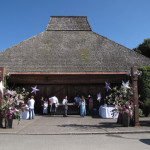The recent crisis at the Met has raised so many questions, as has the demise of the NYCO, the near-demise of the San Diego Opera and the Rome Opera’s uncertain future. Are grand, starry opera productions in the style of those high-profile companies still viable in today’s economy and culture? Are they nothing but soulless, overblown spectacle that isn’t worth trying to save? Or are they the very heart and soul of the art form of opera? Does any attempt to make opera simpler and less expensive inevitably feel “lacking”? And should we agree with Peter Gelb’s artistic vision or with his detractors? Are modernized, avant-garde and otherwise “new and different” productions the only way to keep the standard repertoire compelling? Or do traditional, period-dress productions still have a place in the world?
All these questions take my mind back to 2012: the year I saw two very different productions of La Bohéme, one in May and one in September. The first, at the LA Opera, was a typical big-city production with a starry cast, a full orchestra and lavishly realistic sets and costumes. The second, at the Hidden Valley Music Seminars in Carmel Valley, was a small-scale, low-budget production with a cast of lesser-known singers and only nine musicians. I reviewed them both at the time, but I feel like revisiting them now. Comparing and contrasting those two Bohémes has helped me find my personal answers to all the questions that the recent crises raise.
The LA Opera Bohéme, like all LA Opera productions, was staged at the Dorothy Chandler Pavilion, the glamorous, 3,197-seat former home of the city’s Philharmonic and the Academy Awards. It’s always a thrill to ride through the skyscrapers of downtown LA, then walk across the Music Center courtyard, past the gorgeous fountain and into the Pavilion, and then wander through the elegant marble- and mirror-walled lobby, looking at the various busts and sculptures and the magnificent crystal chandeliers. Sometimes I buy a cookie or a fruit-and-cheese plate at one of the refreshment stands; other times I buy a DVD, a book or a CD set at the souvenir stand. And I always love walking into the massive auditorium with its three balconies, red plush seats, chandelier-lined walls and golden sun-patterned curtain that towers over the orchestra pit.
The Hidden Valley Music Seminars felt like a totally different world. The little wooden theatre with its sloping shingled roof was originally built to house church plays, but some people assume that it used to be a barn – understandably, since it looks like a barn. Instead of skyscrapers, I rode past gorgeous green hills on the way. There was no lavish lobby – only a little outdoor courtyard studded with bushes, flowers, shrubs and trees. There were no balconies, no golden curtain, and certainly no chandeliers – just a little black-box stage surrounded by 300 wooden seats. There were no souvenirs for sale, but there was plenty of food, and not just the elegant nibbles that the Dorothy Chandler offers – in honor of Bohéme’s Parisian setting, there was a plethora of croissants, macarons, cream puffs and other French snacks. And there was no orchestra pit – the musicians performed next to the stage, hidden by a curtain, while the singers watched the conductor on strategically placed TV monitors. There was no trace of the elegance or grandeur of traditional opera visits. But guess what? I didn’t mind. In their place was a sense of warmth, closeness to nature, next-door-neighbor friendliness and intimacy.
Naturally, the two productions mirrored their venues. The LA Bohéme, a production by the late film director Herbert Ross that debuted in 1993, was a lush, scenery-porn recreation of 19th century Paris, very much in the vein of Franco Zeffirelli’s iconic La Scala and Met productions. We were treated to full-sized, detailed facsimiles of a garret and rooftop terrace (modeled after a real building – the one where Picasso lived in his bohemian days), a Latin Quarter street, the Café Momus and the Barrier d’Enfer tavern. It was only unrealistic in that the buildings were open-faced, so we could see their insides and their atmospheric surroundings at the same time. The Hidden Valley Bohéme, on the other hand, was simplicity personified. The backdrop for each act was only a door and a curtain, which with various additions (different chairs, different tables, a stove, etc.) became the door and wall of the garret, the café and the tavern. The tiny elevated stage was much too small to accommodate all the action in Acts II and III, so in a clever touch, it served only as the café and tavern in those acts, while the “outdoor” action took place in the surrounding black box area, with the singers entering and exiting through the aisles of the audience. Likewise, the LA costumes were lovingly crafted, authentic-looking 1880s dress designed by the late Peter J. Hall, who also designed the costumes for Zeffirelli’s Met production; the Hidden Valley costumes were simple, generic “19th century” outfits that looked almost handmade.
Comparing the two physical productions was like comparing a show on Broadway to a high school’s staging of the same. But believe it or not, I didn’t think anything was lacking at Hidden Valley. That little production had one big advantage over the big-city one (I’ve said it once and I’ll say it again) – intimacy. In that small space, the singers were just feet away from even the furthest seats and every facial expression was clear to see. We engaged just as closely with the characters as if we were watching a movie, or even more so, since the singers were actually there, in front of us. Besides, the low-budget simplicity was fitting for Bohéme, with its depiction of the simple lives of penniless young artists and grisettes. But I don’t mean to imply that the lavish realism of the LA production was overblown, soulless or inappropriate. Far from it! One of the central components of Bohéme is its atmosphere: the vivid, detailed portrait it paints of what it was like to be a bohemian in Paris, right down to the last echoing tavern song and street vendor’s call. A vividly realistic, atmospheric recreation of Paris is every bit as fitting as shabby minimalism.
In addition to looking different, the two performances were sung in different languages – the LA Bohéme was sung in the original Italian, while the Hidden Valley Bohéme was sung in English. Once again, believe it or not, I liked both choices equally well The original Italian is, of course, the text that Puccini set, its poetry perfectly suits the music, and it’s a beautiful language. Who wouldn’t agree that “Che gelida manina” sounds prettier than “How cold your little hand is”? But the singable English translation used at Hidden Valley was excellent (not a single word felt clunky or out of place), and since we, the audience, were all English speakers, it helped us engage even more closely with the characters and added to the intimacy that defined the production.
But the ultimate success of both productions revolved around the same thing: the performers. If the Hidden Valley singers had been amateurish, then the production wouldn’t have been worth comparing to LA’s; by the same token, if the LA singers had been dull park-and-barkers, the production might have felt like soulless spectacle. But both productions were headed by excellent singing actors who brought their roles to life. Ailyn Perez was an enchanting, moving, lovely-voiced Mimí in LA, as anyone would expect from a singer whose fame is sweeping the world – but so was Rebecca Davis at Hidden Valley, even though her work has been limited so far to the regional American scene. Likewise, both Stephen Costello in LA and Ben Gulley at Hidden Valley were sumptuous-voiced, endearing Rodolfos (both made me like the character, which not all tenors do), and the Musettas of both Janai Brugger and Sara Duchovnay were beautifully sung and flawlessly sassy and sexy, yet fully human and genuinely likeable (another feat that not all singers achieve). I can honestly say that I liked both casts equally well. Nor did I find any fault with the conducting of either LA’s Patrick Summers or Hidden Valley’s Stewart Robertson. Of course at Hidden Valley it was strange at first to hear Puccini’s sumptuous score played by just nine instruments, but miraculously, thanks to the little theatre’s outstanding acoustics, it worked. I never once missed LA’s full orchestra.
I won’t pretend that the productions were completely equal in quality. The chorus at Hidden Valley consisted mainly of volunteers, not professional singers, and frankly, they were a mess. Off-pitch, out of synch with each other, a lot of them elderly and short on voice – you name it. But if only both productions had featured seasoned, well-rehearsed professional choruses, then not a single moment at Hidden Valley would have felt inferior to LA. Smaller, yes, lower–budget, yes, but inferior, no!
And both productions were “traditional.” They both took place in 19th century Paris (though the LA production was set a few decades later than Murger’s era, with the Eiffel Tower in the city skyline and Musetta making her entrance in a motorcar) and neither one tried to radically reinterpret the opera. But neither production was boring in the least. They both included creative staging and both offered fresh, insightful views of the characters. The singers were never allowed to just go through the standard motions.
So how did these two productions answer the questions that permeate the modern opera world?
Well, for starters, they told me that traditional opera productions are still valuable. So is creativity, of course, but creativity can exist within a period-dress context, and good singing actors, a good conductor and insightful stage direction matter far more than any radical production concept.
More importantly, the LA Bohéme taught me that traditional grand opera is still valid, but the Hidden Valley production taught me that other forms of the genre are equally worthwhile. The beauty of a glamorous big-city opera house, lavish sets and costumes, a full orchestra and star singers is an experience I wouldn’t trade for anything in the world. As long as we possibly can, I think we should fight to keep that form of opera thriving – words can’t express how overjoyed I was when the San Diego Opera was saved and when the crisis at the Met was resolved. But when intimate-scale opera like Hidden Valley’s is performed with enough intelligence and artistry, it can be every bit as beautiful an experience as its grand, glamorous counterpart. I hope to see both types of opera many more times in the future, as well as any other types that exist. No matter what the setting, scale or expense, as long as a performance combines storytelling and music into a captivating whole, it captures the essence of opera, and I love it.






Mirto P
August 30th, 2014 at 14:23
Much to think about here, but just two comments:
1) I love the engagement American audiences have with opera in English, even if it’s ‘wrong.’ Never saw an audience enjoy and ‘get’ ‘The Barber of Seville’ more than at an English-language conservatory performance.
2) I wish I’d seen Ailyn Perez’s Mimi!
MP
Melissa Sweet
August 31st, 2014 at 03:26
I loved this post! As a SD County citizen I’ve read about the trials of the Opera House here and I’ve also been to the Dorothy Chandler Pavilion many times (I believe that’s where I saw Phantom of the Opera – I think it’s considered a musical and not opera – eons ago). Thank you for bringing culture into my life again; sadly it’s been too long! I look forward to your next post! 🙂
barber chairs for sale cheap
September 6th, 2014 at 13:38
Wonderful blog! Do you have any tips and hints for aspiring writers?
I’m hoping to start my own blog soon but I’m a little
lost on everything. Would you advise starting with a free platform
like WordPress or go for a paid option? There are so many options out there that I’m totally confused
.. Any suggestions? Thank you!
Pamina
September 9th, 2014 at 14:08
I’d start with WordPress. That’s what I did, anyway.